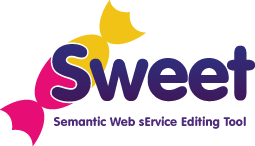About

SWEET was the first tool developed to support users in creating semantic RESTful services by structuring service descriptions and associating semantic annotations. The aim was to support a higher level of automation when performing common tasks with RESTful services, such as their discovery and composition.
iServe was a platform for publishing Semantic Web Services as linked data, regardless of their original format. iServe built upon the Web of Data principles and used as its core what was referred to as the Minimal Service Model, a minimal vocabulary for describing services in RDF, which abstracted away from the original approach used for annotating the services, such as SAWSDL, WSMO-Lite, MicroWSMO, or OWL-S. When posting semantic descriptions created with SWEET, the RDF was directly converted to the Minimal Service Model and was stored together with the original MicroWSMO description.
Sweet Demo
Here are a set of video screen-casts which show how to complete the main annotation tasks.
- Marking of service properties with the help of hRESTS tags within the HTML Web API description.
This video shows how with Sweet you could, mark the service properties and how to rename and delete them.
Adding semantic annotations to the service properties. This video shows how Sweet allowed you to search for suitable ontologies and add, remove or modify semantic annotations.
Saving and exporting the created semantic service description. This video shows how Sweet allowed you to save the annotated HTML to a local machine, how to extract the semantic description in RDF and how to post it to the iServe service repository.
SWEET was implemented in two main versions. The first version took the form of a vertical widget displayed within a Web browser. It was very lightweight and could be used to directly annotate RESTful service descriptions visualised in the browser window. The second implementation was part of a fully-fledged dashboard application developed within the SOA4All project, which supported users in performing different tasks related to the service lifecycle. Both SWEET implementations shared common main functionalities:
- Insertion of hRESTS microformat tags in the HTML service descriptions in order to mark service properties (operations, address, HTTP method, input, output and labels).
- Integrated ontology search for linking semantic information to service properties.
- Insertion of MicroWSMO model reference tags, pointing to the associated semantic meaning of the service properties.
- Saving of semantically annotated HTML RESTful service description, which could be republished on the Web.
- Extraction of RDF MicroWSMO service descriptions based on the annotated HTML.
Acknowledgments
The development of the SWEET tool was based on work partially supported by EU funding under the SOA4All project (FP7 – 215219). Additionally, we thank Laurian Gridinoc and Simone Spaccarotella for their contributions to the development of SWEET.
Publications
Duke, A., Stincic, S., Davies, J., Lecue, F., Mehandjiev, N., Pedrinaci, C., Maleshkova, M., Domingue, J., Liu, D. and Alvaro, G. Telecommunication mashups using RESTful services, ServiceWave 2010.
Maleshkova, M., Kopecky, J. and Pedrinaci, C. (2009) Adapting SAWSDL for Semantic Annotations of RESTful Services Workshop: Beyond SAWSDL at OnTheMove Federated Conferences & Workshops, November 2009.
Maleshkova, M., Pedrinaci, C., and Domingue, J. (2009) Semantically Annotating RESTful Services with SWEET Demo at 8th International Semantic Web Conference, October 2009.
Maleshkova, M., Pedrinaci, C., and Domingue, J. (2009) Supporting the Creation of Semantic RESTful Service Descriptions Workshop: Service Matchmaking and Resource Retrieval in the Semantic Web (SMR2) at 8th International Semantic Web Conference, October 2009.
Maleshkova, M., Gridinoc, L., Pedrinaci, C., and Domingue, J. (2009) Supporting the Semi-Automatic Acquisition of Semantic RESTful Service Descriptions, Poster at ESWC 2009.